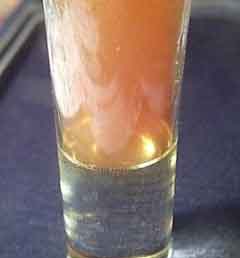
Nitric acid
Nitric acid (HNO3) - one of the strong monobasic acids with a sharp suffocating smell, sensitive to light and in bright light decomposes into one of the nitrogen oxides (also called brown gas - NO2 ) and water. Therefore, it is desirable to store in dark containers. In concentrated state, it does not dissolve aluminum and iron, so can be stored in appropriate metal containers.
Nitric acid - is a strong electrolyte like many acids and a very strong oxidizer. It is often used in reactions with organic substances.
Anhydrous nitric acid - colorless volatile liquid (Tboil.=83 °C; due to the volatility of anhydrous nitric acid is called "Smoking") with a pungent smell.
Nitric acid as ozone can be formed in the atmosphere at flash of lightning. Nitrogen, that is 78% of the atmospheric air, reacts with atmospheric oxygen, forming a nitric oxide NO. With further oxidation in the air, this oxide goes to nitrogen dioxide (NO2 brown gas), which reacts with atmospheric moisture (clouds and fog), forming nitric acid. But such a small number it is absolutely harmless for the ecology of the earth and living organisms.
One volume of nitric acid and three volumes of hydrochloric acid form a compound called "Royal vodka" . It is capable of dissolving metals (platinum and gold), insoluble in other ordinary acids. When you make this mixture of paper, straw, cotton, will occur oxidation, even the ignition.
When boiling, it is decomposed into components (chemical decomposition reaction):
HNO3 = 2NO2 +O2 + 2H2O - brown gas is released (NO2), oxygen and water.

Brown gas is released from nitric acid when heated
Properties of nitric acid
Properties of nitric acid can be varied even in reactions with the same substance. They are directly dependent on the concentration of nitric acid. Let us consider the options of chemical reactions.
the- concentrated nitric acid:
With metals iron (Fe), chromium (Cr), aluminum (Al), gold (Au), platinum (Pt), iridium (Ir), sodium (Na) - does not react due to the formation of a protective film on their surface, that does not allow further oxidize the metal.
With all other metals produce brown gas during chemical reaction
(NO2). For example, in a chemical reaction with copper (Cu):
4HNO3 конц. + Cu = Cu(NO3)2 + 2NO2 + H2O
With nonmetals, for example with phosphorus:
5HNO3 conc. + P = H3PO4 + 5NO2 + H2O
- decomposition of nitric acid salts
Depending on the dissolved metal, the decomposition of the salt at a temperature occurs as follows:
Any metal (labeled Me) up to magnesium (Mg):
MeNO3 = MeNO2 + O2
Any metal from magnesium (Mg) to copper (Cu):
MeNO3 = MeO + NO2 + O2
Any metal after copper (Cu):
MeNO3 = Me + NO2 + O2
- nitric acid, diluted:
When interacting with alkaline earth metals, as well as zinc (Zn), iron (Fe), it is oxidized to ammonia
(NH3) or to ammonium nitrate (NH4NO3). For example, at the reaction with magnesium (Mg):
10HNO3 diluted. + 4Zn = 4Zn(NO3)2 + NH4NO3 + 3H2O
But nitrous oxide can also be formed (N2O), for example, in reaction with magnesium (Mg):
10HNO3 diluted. + 4Mg = 4Mg(NO3)2 + N2O + 5H2O
Reacts with other metals to form nitric oxide (NO), for example, dissolves silver (Ag):
2HNO3 diluted. + Ag = AgNO3 + NO + H2O
Similarly reacts with nonmetals, for example with sulfur:
2HNO3 diluted. + S = H2SO4 + 2NO - oxidation of sulfur to the formation of sulfuric acid and nitric oxide gas evolution.
- chemical reaction with metal oxides, e.g. calcium oxide:
2HNO3 + CaO = Ca(NO3)2 + H2O - salt (calcium nitrate) and water are formed
- chemical reaction with hydroxides (or bases), e.g. slaked lime
2HNO3 + Ca(OH)2 = Ca(NO3)2 + H2O - salt is formed calcium nitrate) and water-neutralization reaction
- chemical reaction with salts, e.g. with chalk:
2HNO3 + CaCO3 = Ca(NO3)2 + H2O + CO2 - the salt (calcium nitrate) and other acid is formed (in this case, a carbonic acid is formed and it breaks down into water and carbon dioxide).